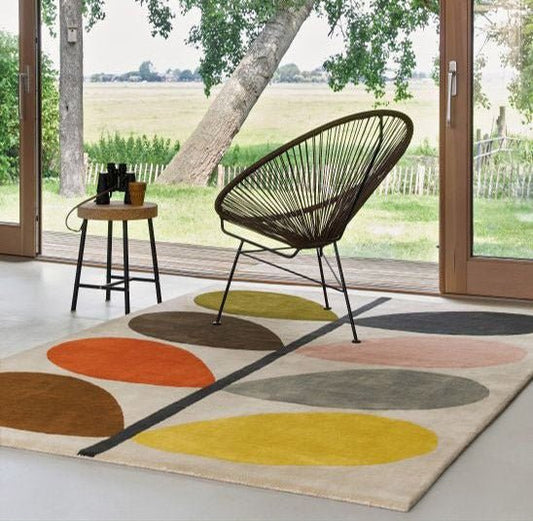A converted 1930s cottage with a vintage Art Deco interior, available to stay in through the National Trust
The 1930s were a transformative decade in British home design. With economic shifts and a gradual recovery from the Great Depression, interior design trends evolved to reflect both the resilience and newfound optimism of the era.
From the enduring appeal of Art Deco to the gradual revival of traditional British decor, the period offered an intriguing mix of influences.
Read on to explore the iconic styles that defined British homes during the 1930s, from the luxurious homes of the wealthy to the practical, stylish spaces of middle-class.
The Influence of Art Deco on 1930s Interiors
The Art Deco movement, which began in the 1920s, continued to shape interior design in early 1930s Britain.
Art Deco was particularly popular in upper-class homes but also filtered into the decor of middle-class households looking to add a touch of sophistication.
An original 1930s suburban house shared by Locality
Key Features
Art Deco interiors were defined by geometric shapes, clean lines, and a strong sense of symmetry. Decorative details often included sunburst motifs, stepped forms, and mirrored finishes.

1930s/40s Design Period shared by Wallpaper Direct
Materials and Finishes
Opulent materials like lacquered wood, chrome, glass, and marble were frequently used in furniture and accessories. These finishes created a polished look that embodied modern luxury.
Colour Palette
Art Deco favoured rich, jewel-toned colours like emerald green, deep blue, and burgundy, often paired with gold or silver accents for a sense of drama and contrast.
Rugs
Rugs in Art Deco-inspired homes often had bold, graphic patterns in neutral or monochrome tones, or in deep colours that matched the surrounding decor. Geometric patterns and monochromatic schemes were popular, lending a sense of structured elegance to rooms.
Explore our Art Deco Rug Collection.
Middle-Class Comfort with a Hint of Glamour
While Art Deco dominated the early 1930s, there was a growing interest in traditional British aesthetics, particularly in more affluent households. This revival focused on British heritage, with a preference for classic designs, rich wood tones, and high-quality craftsmanship.

The interior of a 1930s living room shared by Rare Historical Photos
Furniture Styles
Wealthier households often favoured antique or antique-style furniture with detailed carvings and high-quality wood like mahogany or oak. This furniture added a sense of heritage and luxury, creating an atmosphere of timeless elegance.
Patterns and Textiles
Traditional patterns such as damask, floral, and chintz were popular, often used in curtains, upholstery, and cushions. These textiles brought a cosy, familiar feel to spaces, contrasting with the more modern look of Art Deco.

1930s Floral Damask Vintage Wallpaper from Hannah's Treasures
Rugs
Persian and Oriental rugs were especially favoured by affluent homeowners who could afford imported pieces. These hand-knotted rugs added colour and intricacy to a room, providing a beautiful contrast to the more restrained tones of walls and furniture.
Explore our Traditional Rug Collection.
Accessories and Accents
Wealthier homes featured detailed accessories like brass candle holders, porcelain figurines, and hand-painted ceramics. These decorative items highlighted the importance of craftsmanship and added a curated feel to each room.
How to Bring 1930s Inspiration to Modern Homes
The design trends of the 1930s still inspire modern interiors, blending vintage elegance with contemporary comfort.
Whether you're drawn to Art Deco’s bold shapes or the cosy feel of traditional British decor, there are plenty of ways to incorporate these influences into today’s spaces.
Art Deco Accents
Add an Art Deco touch with a geometric-patterned rug, a vintage-inspired mirror, or a piece of statement lighting. These small additions can bring glamour and a hint of 1930s style to any room.

Image Credit: Margarita Bravo
Traditional Elements
For a more classic look, consider rich wood furniture, floral textiles, or a Persian-style rug. These timeless pieces create a warm, welcoming environment reminiscent of traditional 1930s homes.

Image Credit: Becca Interiors
Colour Palette
To achieve a 1930s-inspired colour scheme, use soft neutrals as a base, then layer in jewel tones or pastels for accents. This creates a balanced look that’s both stylish and sophisticated.
Bringing the 1930s Style Home
The 1930s was a decade of unique style contrasts, from the structured sophistication of Art Deco to the charm of traditional British decor.
For those who could afford to explore design trends, this era offered a fascinating blend of luxury and comfort.
By drawing on these historical influences, today’s interiors can capture the enduring elegance of the 1930s and bring a touch of vintage character to modern homes.




